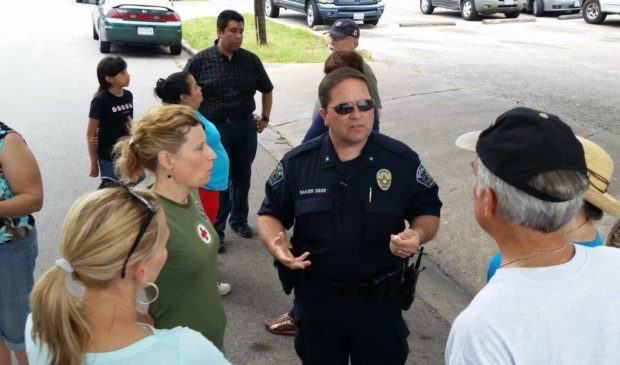Rundberg residents search for resources to continue restoration
Monday, June 12, 2017 by
Chad Swiatecki Residents of Rundberg Lane in North Austin saw many benefits during the three years the area received a stepped up police presence thanks to a $1 million federal grant that concluded last year.
Crime, especially in a handful of “hotspots,” decreased or was nearly eliminated, and police walking community beats became aware of quality of life and public health issues that they helped address by alerting social service organizations. The three-year Restore Rundberg project was seen as a success that started to remedy the mix of crime and quality of life issues that have plagued the community for years.
With the grant now concluded and police levels mostly back to pre-grant levels, residents in the area are continuing to assemble and working to keep the Restore Rundberg project going, even if they’ll have to do so by patching together community resources instead of having a beefed-up police presence leading the charge.
Help has come through donations and programs from Frost Bank, St. David’s Foundation and Latino HealthCare Forum, among others, including a recent health care training program that produced 24 graduates ready to fill needed jobs in the health care field.
As a side benefit to that program, some of the graduates were employed in the area and can help communicate with residents speaking Spanish, Arabic and a variety of Asian regional languages that are common in that part of North Austin.
One thing that all agree would help: having a city employee in charge of marshaling local organizations, volunteers and possibly future grant dollars, which would magnify the work of volunteers in the area. Monica Guzmán, chair of the Rundberg Revitalization Team, said she and others have requested creation of the position, which carries a price tag estimated at $80,000.
“I know that the budget is leaner this year, so I don’t know if that makes it a bigger longshot or not,” she said. “We started the talks earlier this year to let (City Council Member) Greg Casar and his staff know how much it would help to have someone inside the city who could reach out to organizations and find ways to cross the language barriers we have here.”
Along with continuation of the walking beats and increased police presence, a University of Texas study recommended continued dialogue between residents to collaborate on local issues, creation of a coalition of landlords and property owners to address housing quality, creation of a city community engagement coordinator position with the city and public investment in a pair of educational programs for at-risk youth.
Guzmán and other Restore Rundberg volunteers have taken to holding meetings every other month to discuss the issues that need attention and how to best address them. While crime has decreased in most of the area thanks to the three years of police work, she said the intersection of Rundberg Lane and North Lamar Boulevard has become a problem area because of violence between drug dealers and the homeless population in the area.
Related to that issue is a low median income and a lack of quality affordable housing, with the UT study finding that 30 percent of the 38,000 residents in the Rundberg neighborhood live under the poverty level of $11,770 per year for a single-person household.
Add in the area’s ongoing role as a resettlement zone for refugees and, Guzmán said, you get a high level of residential turnover that makes it hard to create buy-in on efforts to improve the community.
“The majority of people are struggling day to day, juggling two or three jobs just to survive,” she said. “When you look at the housing in the area there’s lots of properties not being maintained, with no accountability to the city.”
Other volunteers and residents agree that the language barriers and a high concentration of renters make it difficult for commonplace solutions to take hold. One possible bright spot comes from meetings earlier this year with Dell Medical School’s Center for Place-Based Initiatives, though that is still in the preliminary phase.
“There’s a disconnect in the conversation, so we’ve been working with Monica and the YMCA to get more of a Hispanic presence in the neighborhoods and get the conversations going,” said Randy Teich, the area’s planning representative for the North Austin Civic Association. “We should be able to develop some synergies, because I know that there’s some common desires between all of us.”
Photo courtesy of the city of Austin.
The Austin Monitor’s work is made possible by donations from the community. Though our reporting covers donors from time to time, we are careful to keep business and editorial efforts separate while maintaining transparency. A complete list of donors is available here, and our code of ethics is explained here.
You're a community leader
And we’re honored you look to us for serious, in-depth news. You know a strong community needs local and dedicated watchdog reporting. We’re here for you and that won’t change. Now will you take the powerful next step and support our nonprofit news organization?









